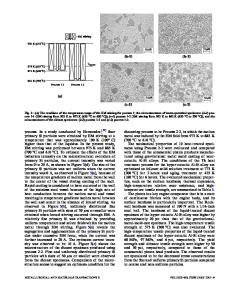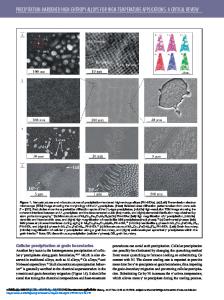Effects of high temperature fatigue on microstructure and mechanical properties of a nickel-base precipitation hardened
- PDF / 3,100,767 Bytes
- 10 Pages / 612 x 792 pts (letter) Page_size
- 61 Downloads / 372 Views
I.
INTRODUCTION
ADVANCED engineering designs in power generating systems demand satisfactory materials performance under high temperature, high stress--often alternating--and an extended service period. Most design parameters for the structural components are based on the mechanical properties of the virgin material. However, there is an increasing concern about the gradual deterioration of microstrncture and the development of microscopic defects which would jeopardize long-term integrity of the components. A certain type of damage evolution which is not envisioned in shorttime laboratory testing may undermine the design criteria based on properties of the virgin material. Recently Arbel ~studied the creep deformation of a solidsolution hardened nickel-base alloy and found that the fracture toughness of the starting material deteriorated significantly well before main rupture. This was attributed to intergranular cavitation. In unpublished research, Hwang and Arbel observed a similar phenomenon in a precipitation hardened Inconel X-750 alloy after creep at 700 °C. Evidence of intergranular cavitation was also found in the specimens after fracture. As Perry documented in a review paper, 2 intergranular cavitation occurs most frequently during creep deformation. To a lesser extent this phenomenon also takes place during high temperature fatigue deformation, typically above 0.5 Tin.* The materials which develop grain boundary *Homologous melting temperature
cavitation during high temperature fatigue include Cu, 3 Cu3Au, 4 Mg, 3 and Mg-0.8A1. 3'5'6 Fatigue with hold-period also induces grain boundary cavitation. Min and R a f found that cavitation due to unbalanced fatigue cyclings significantly affected the rate of crack propagation in Type 316 stainless steel. The present work is an attempt to verify a hypothesis that the mechanical properties of virgin material may deteriorate before the design life because of microstructural damage S.K. HWANG, formerly with the Brookhaven National Laboratory, Upton, NY 11973, is now with the Westinghouse Electric Corp. Research and Development Center, Pittsburgh, PA 15235. C. S. PANDE, formerly with the Brookhaven National Laboratory, is now with the Naval Research Laboratory, Washington, DC 20375. Manuscript submitted January 24, 1983. METALLURGICALTRANSACTIONS A
accumulation. A nickel-base precipitation hardened alloy Inconel X-750 was studied under fatigue deformation at 700 °C. This alloy is often used as bolting material in steam turbines, where alternating stress at elevated temperature is frequently encountered. Tensile properties and fracture toughness were examined at different time intervals, and the results are discussed in the light of the findings on microstructural changes.
II.
EXPERIMENTAL PROCEDURES
The alloy used for this work was commercial Inconel X-750; and its chemical composition, provided by the manufacturer, was Cr 15 pct,* Fe 8 pct, C 0.04 pct, Ti *All in weight percent
2.5 pct, A1 0.7 pct, Nb and Ta total 0.8 pct, Zr 0.02 pct, Si 0.01 pct, Mn 0.01
Data Loading...











